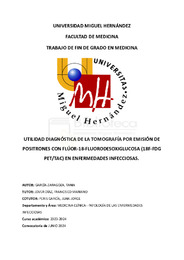Por favor, use este identificador para citar o enlazar este ítem:
https://hdl.handle.net/11000/34037Utilidad diagnóstica de la tomografía por emisión de positrones con flúor-18-fluorodesoxiglucosa (18F-FDG PET/TAC) en enfermedades infecciosas
| Título : Utilidad diagnóstica de la tomografía por emisión de positrones con flúor-18-fluorodesoxiglucosa (18F-FDG PET/TAC) en enfermedades infecciosas |
| Autor : García Zaragoza, Tania |
| Tutor: Jover Díaz, Francisco Mariano Peris García, Juan Jorge |
| Editor : Universidad Miguel Hernández |
| Departamento: Departamentos de la UMH::Medicina Clínica |
| Fecha de publicación: 2024-04-29 |
| URI : https://hdl.handle.net/11000/34037 |
| Resumen : INTRODUCCIÓN: la técnica de imagen 18 Flúor-Fluorodesoxiglucosa tomografía por emisión de positrones/tomografía computarizada (18F-FDG PET/TC) combina la tomografía por emisión de positrones (PET) y la tomografía computarizada (TC) presentando gran utilidad en el diagnóstico, estadiaje y seguimiento de neoplasias. Sin embargo, su utilidad en el diagnóstico y manejo de procesos infecciosos está aún en estudio. Respecto a otras técnicas de imagen presenta algunas ventajas como la precisión en la detección de focos de infección o la evaluación global del paciente, aunque también tiene limitaciones. OBJETIVO: El objetivo principal de este estudio es demostrar la utilidad del examen 18F-FDG PET/TC en distintas patologías infecciosas, así como analizar el valor diagnóstico y su correlación con los diagnósticos de sospecha. Como objetivos secundarios se busca evaluar la utilidad del PET/TC en el manejo clínico de los pacientes y la búsqueda de predictores de positividad de PET/TAC. RESULTADOS Y DISCUSIÓN: el estudio retrospectivo analiza datos de 89 pacientes siendo la mayoría varones (71,9%), con una edad media de 64,5 años. Los síntomas predominantes incluyen fiebre (68,5%) y síntomas respiratorios (38,2%). Las pruebas complementarias previas más comunes fueron las microbiológicas (89,9%) y las de imagen (94,4%). Las indicaciones de PET/TC fueron FOD (27%), infección focal (20,2%), bacteriemia (34,8%) e inmunocomprometido (18%). Los resultados mostraron una confirmación diagnóstica en el 60,7% de los casos. Destacó su utilidad (confirmación y hallazgos inesperados) en un 76,4%. Solo el 9,5% de los pacientes sin diagnóstico inicial tras el PET/TC (n=21) obtuvieron un diagnóstico confirmatorio posteriormente. En el estudio por subgrupos la FOD se asoció a una menor probabilidad de confirmación y de tener utilidad, mientras que en infección focal se asoció a una probabilidad de confirmación mayor. Sin embargo en el estudio multivariante no se mantuvieron estas asociaciones, probablemente derivado del tamaño muestral. CONCLUSIÓN: encontramos que la confirmación diagnóstica es significativamente mejor en pacientes con infección focal, intentando aportar con nuestro trabajo un análisis por subgrupos para optimizar la rentabilidad diagnóstica del PET/TC en algunas indicaciones concretas de enfermedades infecciosas. BACKGROUND: Imaging technique 18 Fluorine-Fluorodeoxyglucose positron emission tomography/computed tomography (18F-FDG PET/CT) combines positron emission tomography (PET) and computed tomography (CT) and presents great utility in the diagnosis, staging and follow-up of neoplasms. However, its usefulness in diagnosing and managing infectious processes is still being studied. Compared to other imaging techniques, it has some advantages, such as accuracy in detecting sources of infection or the overall patient assessment, although it also has limitations. OBJECTIVE: Our main objective is to demonstrate the usefulness of the 18F-FDG PET/CT test in different infectious indications and analyze the diagnostic value and its correlation with suspected diagnoses. Secondary endpoints were included to evaluate the usefulness of PET/CT in the clinical management of patients and predictors of PET/CT positivity. RESULTS AND DISCUSSION: This retrospective study analyzed data from 89 patients, most of whom were male (71.9%), with a mean age of 64.5 years old. Predominant symptoms include fever (68.5%) and respiratory symptoms (38.2%). The most common previous complementary tests performed were microbiological (89.9%) and imaging (94.4%). Indications for PET/CT were fever of unknown origin (27%), focal infections (20.2%), bacteremia (34.8%), and immunocompromised patients (18%). Results showed diagnostic confirmation in 60.7% of cases. Evaluation of its usefulness (confirmation and unexpected findings) reached 76.4%. Only 9.5% of patients without an initial diagnosis after PET/CT obtained a confirmatory diagnosis later. In the subgroup study, fever of unknown origin was associated with a lower probability of confirmation and usefulness, while focal infection was associated with a higher probability of diagnosis confirmation. Nevertheless, after performing a multivariate analysis these associations were not maintained, due to the limited sample size. CONCLUSION: Diagnostic confirmation is significantly better in patients with focal infection, trying to provide with our work a subgroup analysis to optimize the diagnostic yield of PET/CT in some specific indications of infectious diseases. |
| Palabras clave/Materias: 18F-FDG PET/TC Infecciones FOD Bacteriemia Confirmación diagnóstica Utilidad Infections Bacteraemia Diagnostic confirmation Usefulness |
| Área de conocimiento : CDU: Ciencias aplicadas: Medicina |
| Tipo de documento : info:eu-repo/semantics/bachelorThesis |
| Derechos de acceso: info:eu-repo/semantics/openAccess |
| Aparece en las colecciones: TFG- Medicina |
 La licencia se describe como: Atribución-NonComercial-NoDerivada 4.0 Internacional.
La licencia se describe como: Atribución-NonComercial-NoDerivada 4.0 Internacional.
.png)
